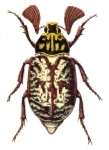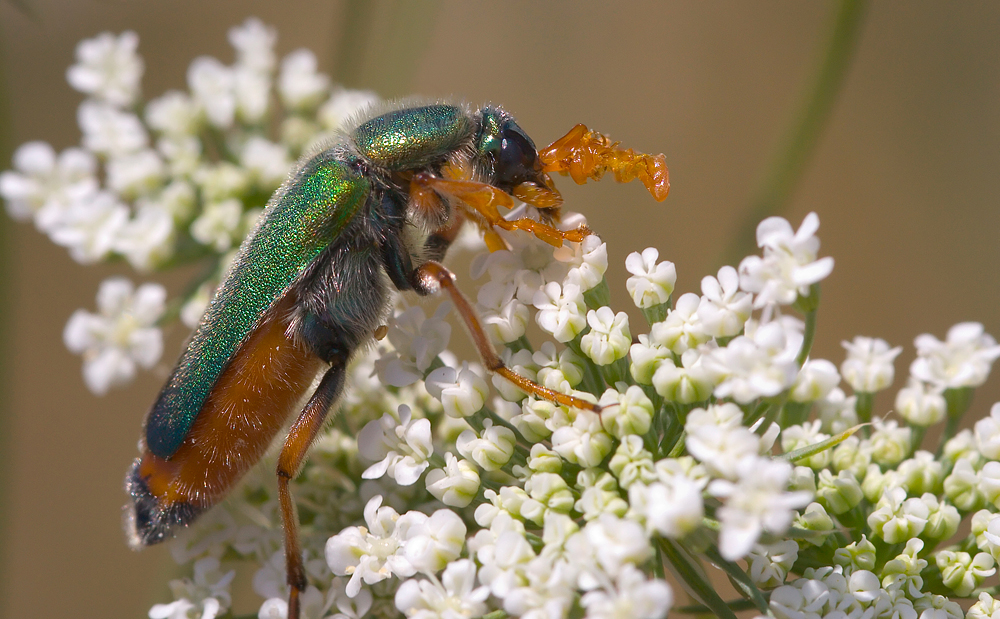|
Description / Habitats / Flora / Vertebrates / Insects / Invertebrates / What's that Bug? Home / Nestos Delta / Bibliography / About this site / Links / Contents / Galleries ____________________________________________________________________________ |
|
__________________________________________________________________________________________________________ THE BLISTER BEETLES (COL., MELOIDAE) OF THÁSOS Blister beetles (or Oil beetles) are a fascinating group with a complex life history, an ability to produce a highly toxic substance, and with many species brightly coloured. Their remarkable life cycle, referring to the morphologically distinct stages of larval development, is known as hypermetamorphism. When the eggs hatch thousands of slender and highly active larvae, called triungulins, seek out host insects to transport them to their eventual food source. Triungulins of many species clamber up flowers to await the arrival of solitary bees on which to hitch a ride to their nest sites, some cluster in thousands at the top of grass stems and emit pheromones to attract male bees, climb on board, and then shift to the female bee when the male mates. The larvae of Cerocoma scheberi, a species known from Thásos, have been recorded from parasitised mantids stored by solitary wasps. Others, including most of the species currently known from Thásos, develop on the egg pods of grasshoppers. In this stage, when they have reached their food source, the triungulin larva feeds up and then changes into a sedentary form that resembles a typical grub-like larva. The adult beetles are phytophagous, feeding on leaves and flowers, and in some countries can be a pest to crops.
Mylabris calida It is the production of cantharidin, however, that will have brought meloids to the attention of most people. This extremely toxic liquid is produced by the male beetles and a small quantity is passed to the female during copulation, which she uses to coat her eggs with. The beetles exude cantharadin from their joints when disturbed to dissuade predators from eating them. As a result many species are aposematic, conspicuously-coloured to warn predators to avoid them. Cantharadin is a blistering agent and causes chemical burning of the skin with external contact. In America several species of Epicauta contain high levels of cantharidin and can pose a fatal threat to horses when they ingest them, especially as concentrations of beetles in hay bales. There are also several reported cases of poisoning in humans, going back over 2000 years to Roman times. It has also been widely used in the past as an aphrodisiac (sometimes with fatal results), notoriously as Spanish Fly from the beetle Lytta vesicattoria which has been recorded on Thasos. Bologna (1994) records 88 species of Meloidae from Greece, but there is very little historic information on the occurrence of this family on Thásos. Karnozickij (1959) reports three species from the island in May 1943, whilst Bologna & Marangoni (1990) add two more species (Mylabris calida and M. quadripunctata). I have seen Meloidae on Thásos on just two occasions (both in June 2005): M. quadripunctata was frequent in a sandy olive grove behind the beach at Trypiti (now developed) and on the coastal grassland at Cap Prinos Cercoma schreberi (an addition to the island list) was commonly swept, along with a single M. variabilis. I also recorded M. calida in some abundance on road verges by Kavala Airport in the same month, but so far have not seen this species on Thásos. Bologna's checklist (1994) provides the most up to date overview of the Greek Meloidae fauna, but there have been several new species identified since then as this is a taxonomically difficult family. Turco & Bologna (2011) provide a key to Cerocoma, for which Greece is a biodiversity hotspot, and Bologna & Di Guilio (2006) do likewise for Teratolytta (although only one species in this genus, T. dives, is known from Greece). Cerocoma schreberi (S. Gregg) CHECKLIST
Cerocoma schreberi Fabricius, 1781
*
REFERENCES
Bologna, M.A. 1994. I Meloidae della Grecia (Coleoptera). Fragmenta Entomologica, 25 (Suppl.): 1-119. Bologna, M.A. & Di Guilio, A. 2006. Revision of the genus Teratolytta (Coleoptera: Meloidae). Eur. J. Entomol. 103: 137–161 Bologna, M.A. & Marangoni C., 1990. Dispersal, dispersion and phoresy in blister beetles fauna (Coleoptera, Meloidae) of Eastern Mediterranean and other islands. Accad. naz. Lincei, Atti Conv. Lincei, 85: 345-366. Karnozickij, N. 1959. Materialien zur Koleopteren-Fauna der Agäischen Küste und Insel Thasos. Izv. zool. Inst. Sof., 8: 237-253. Turco, F. & Bologna, M.A. 2011. Systematic revision of the genus Cerocoma Geoffroy, 1762 (Coleoptera: Meloidae: Cerocomini). Zootaxa, 2853: 1-71.
|

















%20Kavala%202005.jpg)
